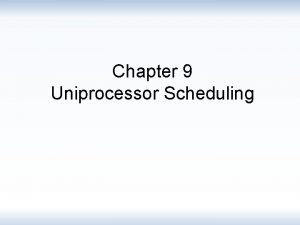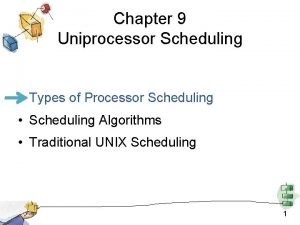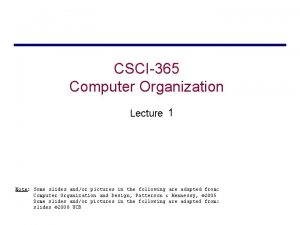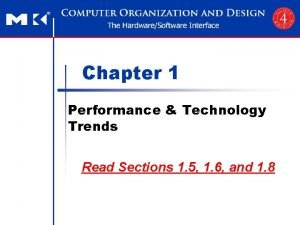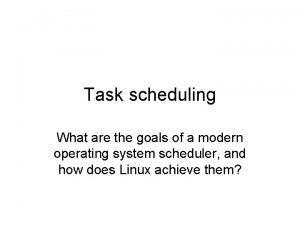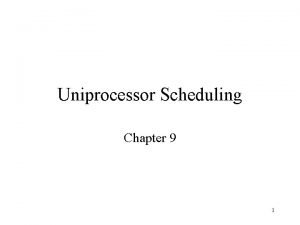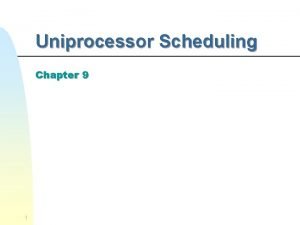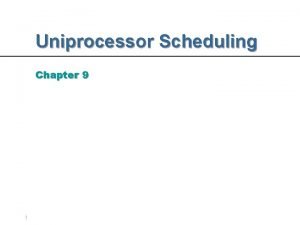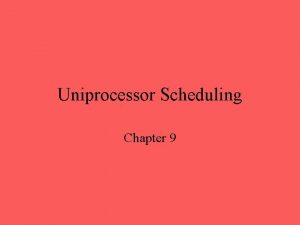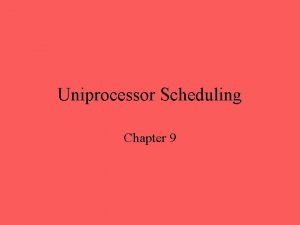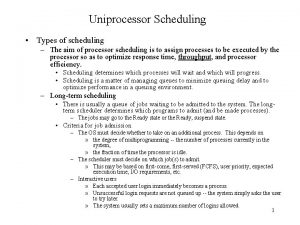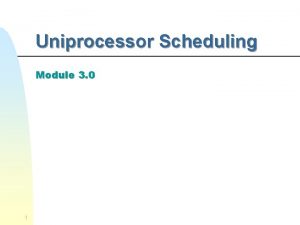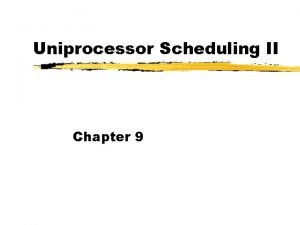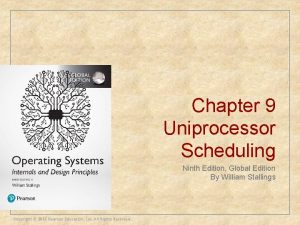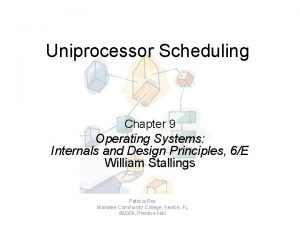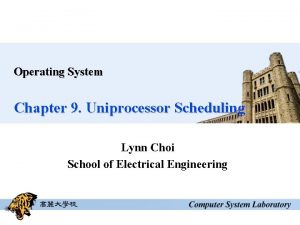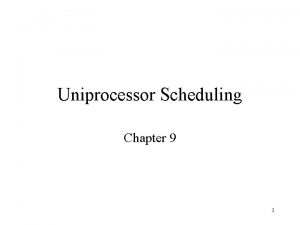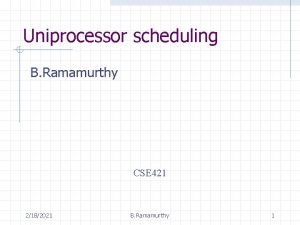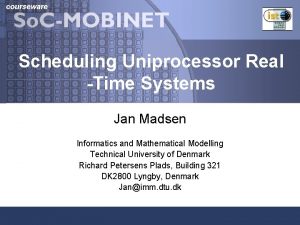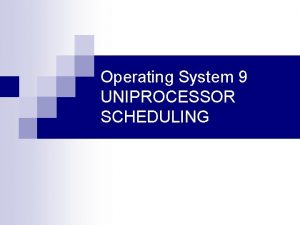Uniprocessor Scheduling I Chapter 9 Goals of Scheduling






















- Slides: 22

Uniprocessor Scheduling I Chapter 9

Goals of Scheduling z Quick response time z Fast throughput z Processor efficiency

Type of Scheduling (1) z Long-term y performed when new process is created y The decision to add to the pool of processes to be executed (chapter 3, process control) z Medium-term y swapping y The decision to add to the number of processes that are partially or fully in main memory (chapter 7 and 8, control structure)

Types of Scheduling z Short-term y which ready process to execute next y decision as to which ready process will be executed by the processor (chatter 9 and 10) z I/O y decision as to which process’s pending I/O request shall be handled by available I/O device (chapter 11)

Scheduling and Process State Transition New Long-term scheduling Ready, suspend Long-term scheduling Ready Medium-term scheduling Blocked, suspend Blocked Medium-term scheduling Running Short-term scheduling Exit

A Seven-State Model - States z Ready: The process is in main memory and available for execution. z Blocked: The process is in main memory and awaiting an event. z Blocked, suspend: The process is in secondary memory and awaiting an event. z Ready, suspend: The process is in secondary memory but is available for execution as soon as it is loaded into main memory.

Queuing Diagram for Scheduling Long-term scheduling Batch jobs Time-out Ready Queue Short-term scheduling Release Processor Medium-term scheduling Interactive users Ready, Suspend Queue Medium-term scheduling Blocked, Suspend Queue Blocked Queue Event Occurs Event Wait

Long-Term Scheduling z Determines which programs are admitted to the system for processing z Controls the degree of multiprogramming z More processes, smaller percentage of time each process is executed

Medium-Term Scheduling z Swapping z Based on the need to manage multiprogramming

Short-Term Scheduling z Known as the dispatcher z Invoked when an event occurs y clock interrupts y I/O interrupts y operating system calls y signals

Short-Tem Scheduling Criteria z User-oriented y Related to the behavior of the system as perceived by the individual user or process. y Response Time: Elapsed time between the submission of a request until there is output. z System-oriented y The focus if on effective and efficient utilization of the processor

Short-Term Scheduling Criteria z Performance-related y Performance-related criteria are quantitative and generally can be readily measured. y measurable such as response time and throughput z Not performance related y predictability: a given job should run in about the same amount of time and at about the same cost regardless of the load on the system

Priorities z Scheduler will always choose a process of higher priority over one of lower priority z Have multiple ready queues to represent each level of priority z Lower-priority may suffer starvation y allow a process to change its priority based on its age or execution history

Priority Queuing RQ 0 A set of queues to instead of a single ready queue Release Dispatch Processor RQ 1 . . . Admit RQn Priority [RQi] >[RQj] Preemption for i<j Event Wait Event occurs Blocked Queue

Decision Mode z Nonpreemptive y Once a process is in the running state, it will continue until it terminates or blocks itself for I/O z Preemptive y Currently running process may be interrupted and moved to the Ready state by the operating system y Allows for better service since any one process cannot monopolize the processor for very long

An Example for Scheduling Policies Process 1 Arrival Time 0 2 2 3 6 3 4 4 6 4 5 5 8 2 Service Time

First-Come-First-Served (FCFS) 0 5 10 15 20 1 2 3 4 5 z Each process joins the Ready queue z When the current process ceases to execute, the oldest process in the Ready queue is selected

Turnaround Time and Service Time z Turnaround Time Tq - the total time that the item spends in the system (waiting time plus service time, or finish time mines arrival time). z Service Time Ts - Finish Time minus Start Time. z Normalized Turnaround Time - the ratio of turnaround time to service time Tq / T s

FCFS -Normalized Turnaround Time Process Arrival Serve Start Finish Turnaround Tq/Ts Time Time Tq A 0 1 1 1 B 1 100 1 C 2 1 102 100 D 3 100 102 202 199 100 26 Mean

Difficulties with First-Come-First-Served z A short process may have to wait a very long time before it can execute z Favors CPU-bound processes y CPU-bound processes: the processes mostly use processor. y I/O processes have to wait until CPU-bound process completes

Round-Robin q=1 5 0 1 2 3 4 5 0 2 2 3 10 4 5 6 6 15 20 Ready Time 7 8 8 9 10 14 13 11 12 16 z Uses preemption based on a clock z An amount of time is determined that allows each process to use the processor for that length of time z Next ready job is selected.

Round-Robin q=4 5 0 1 2 3 4 5 0 2 Ready Time P 2 rest part ready time is 7 P 4 rest part ready time is 15 P 5 ready time is 8 10 15 20 7 4 Ready Time 6 15 8 P 4 rest part ready time is 15 P 5 ready time is 8
 Uniprocessor scheduling in os
Uniprocessor scheduling in os Processor
Processor Strategic goals tactical goals operational goals
Strategic goals tactical goals operational goals Strategic goals tactical goals operational goals
Strategic goals tactical goals operational goals Parallelism in uniprocessor system
Parallelism in uniprocessor system Uniprocessor
Uniprocessor Uniprocessor
Uniprocessor General goals and specific goals
General goals and specific goals Examples of generic goals and product-specific goals
Examples of generic goals and product-specific goals Goals of scheduling
Goals of scheduling Sjn scheduling
Sjn scheduling Discourage criminal acts by threatening punishment
Discourage criminal acts by threatening punishment Advantages and disadvantages of observation method
Advantages and disadvantages of observation method Workshop goals examples
Workshop goals examples Work immersion objectives
Work immersion objectives Women's ministry goals and objectives
Women's ministry goals and objectives Women's ministry goals and objectives
Women's ministry goals and objectives Lenovo vision statement
Lenovo vision statement School readiness goals
School readiness goals Dependency theory ap human geography
Dependency theory ap human geography Avid smart goals
Avid smart goals Objectives of warehouse management
Objectives of warehouse management Perspective taking goals
Perspective taking goals
